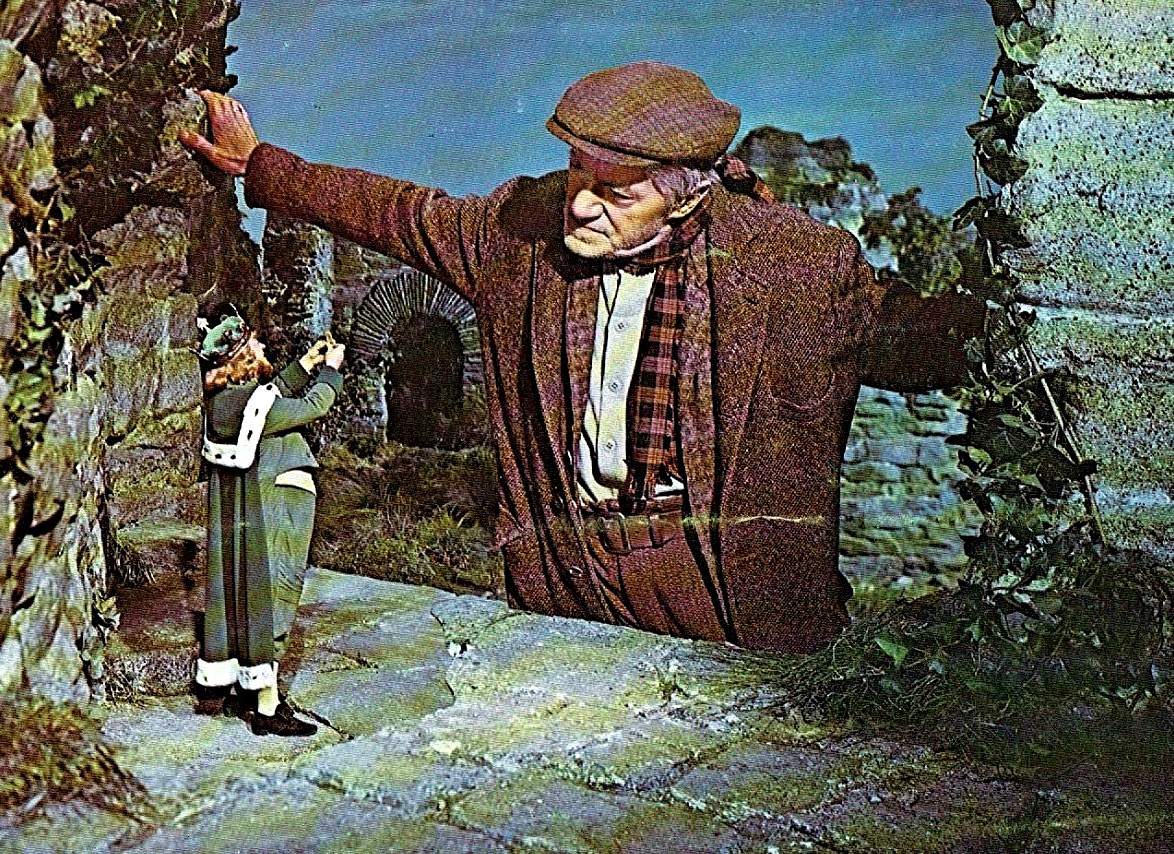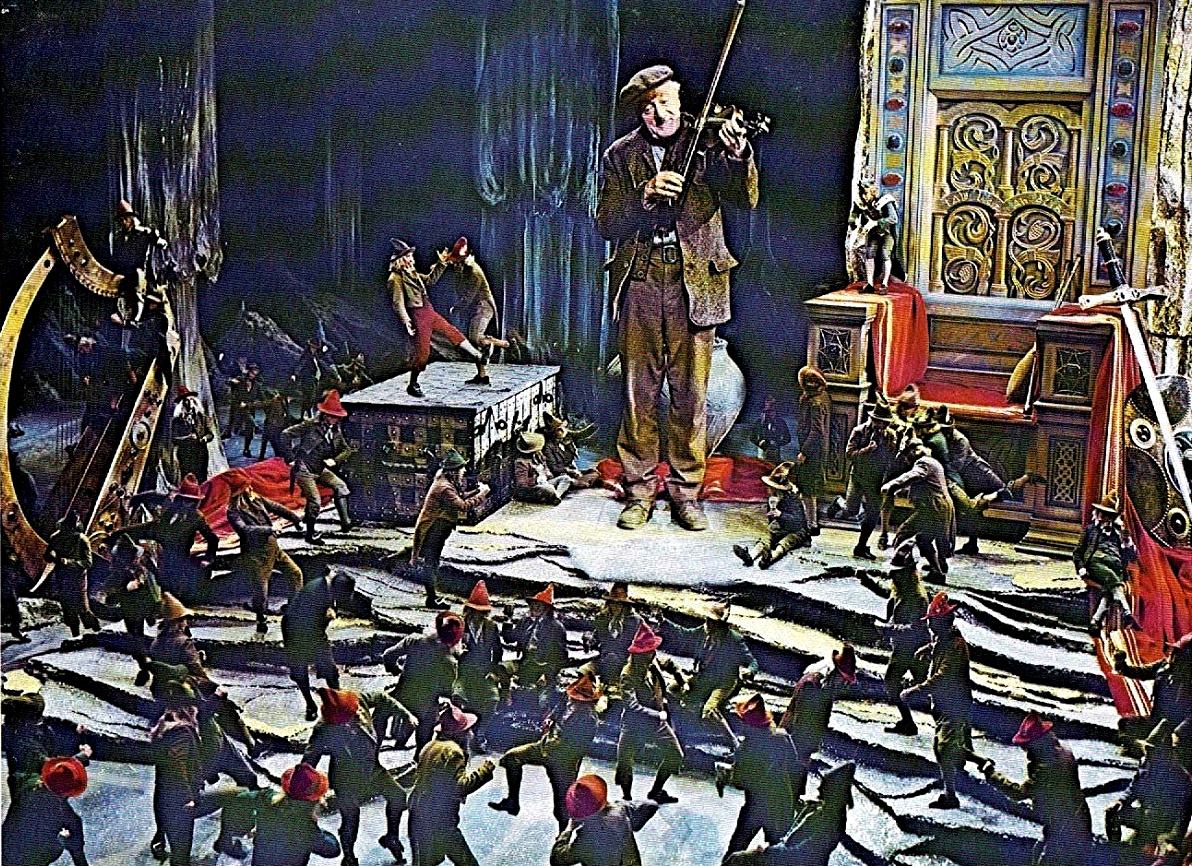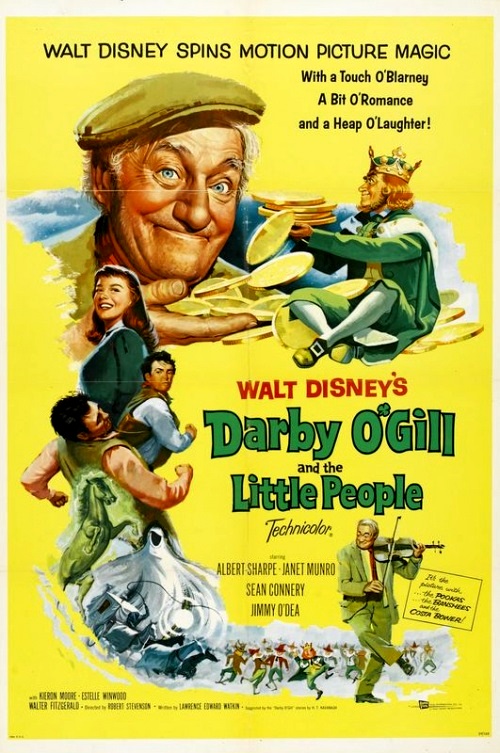Crew
Director – Robert Stevenson, Screenplay – Lawrence Edward Watkin, Based on the Story Collection Darby O’Gill and the Good People (1903) by H.T. Kavanagh, Producer – Walt Disney, Photography – Winton C. Hoch, Music – Oliver Wallace, Songs – Wallace & Watkin, Photographic Effects – Peter Ellenshaw & Eustace Lycett, Animation – Joshua Meador, Art Direction – Carroll Clark. Production Company – Disney.
Cast
Albert Sharpe (Darby O’Gill), Jimmy O’Dea (King Brian Connors), Janet Munro (Katie O’Gill), Sean Connery (Michael McBride), Kieron Moore (Pony Sugrue), Estelle Winwood (Sheelagh Sugrue)
Plot
Wily old Darby O’Gill finds that he is about to be replaced as the caretaker of Lord Fitzpatrick’s estate. By accident, he falls down a well and finds himself in the kingdom of the leprechauns. He is able to capture the leprechaun king Brian Connors. He announces that he intends to keep Brian imprisoned until he agrees to grant him three wishes with which he hopes to secure a future for he and his daughter Katie.
To my mind, Darby O’Gill and the Little People is the best live-action film that Disney ever produced. Later Disney live-action films were almost invariably comedies, but the 1950s was an era where their live-action output was geared towards adventure films and some remarkable evocations of the fantastic.
Darby O’Gill and the Little People was made during the era when Disney maintained its own in-house special effects studio and sports some truly amazing effects sequences for its time. The blending of full-size actors with the tiny leprechauns is achieved entirely by the use of forced perspective depth effects – where the actors playing the large-size people are placed in the foreground and the smaller-size ones at a distance so as to appear larger/smaller in relation to one another – a process that gets around the need for optical patching and the problem of graininess in multiple reprintings and sloppy matte lines. (The lighting required to make sure the sets were in perspective used up so much electricity it apparently blew out a substation in Burbank when the lights were turned on without warning). The scenes with hundreds of leprechauns dancing and racing on ponies around giant-sized Albert Sharpe is an astounding feat when this is considered.

The best thing in the film is the sly, shrewd performance from Albert Sharpe as Darby. With Popeye squint and a crusty rambunctiousness, Albert Sharpe gets to run the entire gamut of a performance from shameless conman transparency to moving self-sacrifice. The film also features a 29 year-old Sean Connery, playing the romantic lead in one of his very first film roles. Connery hardly strains himself here – most unexpected is to see him singing, something which, as the character apologises for, he does not do a particularly animated job of.
There are also fine performances from Estelle Winwood; Kieron Moore, who bears an amazing resemblance to Clancy Brown; Janet Munro, who plays with this perky friskiness and a lovely twinkle that lights up her soft freckled face; and Jimmy O’Dea as King Brian, who almost matches Sharpe in the boisterous noisiness of his performance. Whoever coached them has a wonderful ear for dialectic colloquialism.
Darby O’Gill and the Little People is one Disney film that is not scared to venture beyond maudlin cosiness and comedy and go into spooky areas. The appearance of the banshee is an amazingly scary image. However, this is something that only paves the way for the stunningly fantastic image of the arrival of the Costa Bower (the Death Coach) riding through the clouds and departing across the muddy countryside in shadow translucence.

The script is cannily aware of the ‘one that got away’ tall tale territory it is venturing into. The scene in a pub where Albert Sharpe holds the glass of port over the lip of the bag and the locals watch agog as it taken from within and tossed back empty a moment later, followed by the glass being placed up on the shelf in case any local ever doubts is hilarious. It is the perfect distillation of the barroom myths from which these leprechaun stories originated. There is a certain looseness to the stories that show their origin slapped together from H.T. Kavanaugh’s short stories – which originally came in two volumes Darby O’Gill and the Good People (1903) and Ashes of Old Wishes and Other Darby O’Gill Tales (1926) – but it works with great charm.
The film comes with such a droll eccentricity that Disney can insert a thank you in the end credits “to King Brian Connors for co-operation in the making of this film.” The ending is the most ingenious use that Disney ever put their refusal to kill a good character off to – and about the only time it worked without seeming a cheat.
British director Robert Stevenson made a number of other films for Disney that include Disney include The Absent-Minded Professor (1961), In Search of the Castaways (1962), The Misadventures of Merlin Jones (1963), Son of Flubber (1963), Mary Poppins (1964), The Monkey’s Uncle (1965), The Gnome-Mobile (1967), Blackbeard’s Ghost (1968), The Love Bug (1969), Bedknobs and Broomsticks (1971), Herbie Rides Again (1974), The Island at the Top of the World (1974) and The Shaggy D.A. (1976). Before moving to Hollywood, Stevenson also made the Boris Karloff mad scientist film The Man Who Changed His Mind (1936) and the sf film Non Stop New York (1937).
Trailer here


